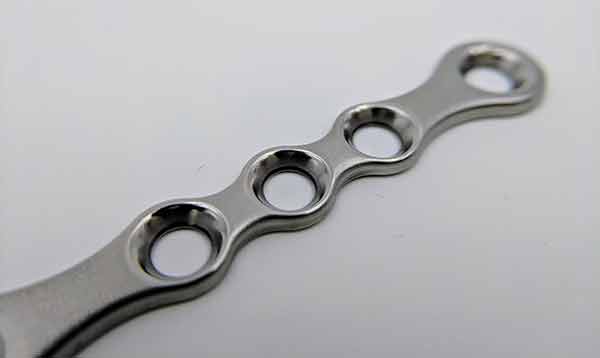Manufacturers should consider Pulsed Electrochemical Machining (PECM) as a viable alternative method to meet increased market demands.
The growth in demand for miniaturized parts, more advanced materials, and more efficient machining processes is creating a burden on many manufacturers and existing manufacturing processes. Particularly vulnerable industries include the aerospace and medical device markets, both industries with a high ratio of critical components and part volumes.
Pulsed electrochemical machining (PECM) may be an alternative solution for cost-efficient, high-volume machining of critical components for aerospace, medical device, and more. We’ll briefly review the intricacies of this complex process and provide examples of its capabilities.
In short, pulsed electrochemical machining is a non-contact, non-thermal material removal process capable of advanced machining rates, more precise machining, and improved repeatability for high-volume parts, in comparison to more conventional machining processes such as electrical discharge machining (EDM).
To start, there are four (4) primary components in PECM:
The tool: Also referred to as the cathode, this tool is custom-machined and designed as the inverse of the desired workpiece geometry. Designing the cathode is a complex process requiring an adept understanding of current density distributions, materials, dielectric coatings, and electrolyte flow.
The workpiece: Also referred to as the anode, the material being machined can be any conductive metal. Common materials for aerospace applications include nickel superalloys, some refractory metals, and metal matrix composites. For medical devices, materials include nitinol, stainless steel, titanium alloys, and cobalt-chrome alloys.
The electrolytic fluid: An electrolytic fluid is constantly pumped between the cathode and anode, also called the interelectrode gap, which has two important roles. Primarily, the electrolyte acts as the conductor for the electrochemical reaction. Secondly, the fluid acts as a flushing agent removing dissolved metal and any excess heat from the process gap–leading to PECM’s unique surface finishing qualities that do not require a secondary finishing process.
The power supply: Power provides the necessary current for the electrochemical reactions and directly correlates with the speed of the process. PECM is a high current (25-150 A/cm2 or 160-970 A/in2), low voltage (5-50V) process, pulsing both the power and cathode for an added layer of precision.
PECM has several unique capabilities not currently present in conventional machining processes.
PECM is a completely non-contact machining process. The gap between the tool and workpiece can be as small as 10-100µm. The pulsing of the cathode also provides additional precision capabilities. As a result of no contact or heat produced (due to the electrochemical reaction lacking a thermal reaction), there is almost no tool wear in PECM, allowing a single cathode to machine thousands of parts with repeatability down to <10µm (.0004 in.). The non-contact and non-thermal nature of PECM also allows precise machining of unique geometries, notably on thin-walled features otherwise sensitive to thermal distortion and tool vibration.
Another unique aspect of PECM is the surface quality, as PECM’s superior surface finishing capabilities is inherent to the process itself. PECM can both machine and finish parts in a single step. The superfinished surface quality of PECM (down to .005 – .04µm, or .19 – 1.57 microinches Ra) is particularly advantageous for applications where flow, surface friction, or cleanliness are critical. For example, the surface quality of an electrochemically machined medical device can meet biocompatibility surface standards, potentially reducing several steps for medical device manufacturers.
An especially valuable trait of PECM is its disregard for material hardness. For PECM, the only qualification for a material is its conductivity—PECM cannot machine nonmetal materials, such as polymers. However, PECM can machine an enormous array of tough materials, irrespective of mechanical properties. For example, PECM can machine a nickel superalloy at the same speed as copper.
Let’s review two brief examples where PECM provides value over competing processes.
Heat exchangers: Heat exchangers play a critical role in aerospace engines. By controlling fuel temperature, heat exchangers provide safety and increased efficiency for the aircraft. Pristine surface quality, high aspect ratios and extremely tight spacing are all crucial for maximizing the efficiency and lifespan of these unique parts. PECM inflicts no thermal stress on the workpiece, making PECM an excellent choice for machining the thin-walled features and high aspect ratios common on microchannel heat exchangers comprised of tough superalloys.

Orthopedic Devices: Orthopedic devices and surgical instruments are continually miniaturizing to allow less invasive surgical procedures and reduce the implant’s contact ratio with the patient. However, downsizing geometries on tough-to-machine materials such as cobalt-chrome and nitinol introduce complications for conventional machining processes. Simultaneously, smooth finishing is essential to meet biocompatibility standards. PECM can machine tough alloys to nearly any desired geometry, simultaneously machining and finishing medical devices.
About the Author:
Daniel Herrington is Founder & CEO of Voxel Innovations, a pioneer in pulsed electrochemical machining (PECM) technology, out of Raleigh, NC. Before starting Voxel, he worked for the technology-to-market team for the Advanced Research Projects Agency—Energy (ARPA-E) program in Washington, D.C and then as an independent consultant for advanced manufacturing agencies. Voxel’s education portal has additional information about PECM and its applications.
Kirk Gino Abolafia is Technical Marketing & Sales Manager of Voxel Innovations. Kirk has written technical articles about electrochemical machining for a variety of publications, including American Machinist, Orthopedic Design & Manufacturing, and Today’s Medical Developments.
If you have additional questions about PECM, contact Voxel at info@voxelinnovations.com
In this episode, I sat down with Beejan Giga, Director | Partner and Caleb Emerson, Senior Results Manager at Carpedia International. We discussed the insights behind their recent Industry Today article, “Thinking Three Moves Ahead” and together we explored how manufacturers can plan more strategically, align with their suppliers, and build the operational discipline needed to support intentional, sustainable growth. It was a conversation packed with practical perspectives on navigating a fast-changing industry landscape.